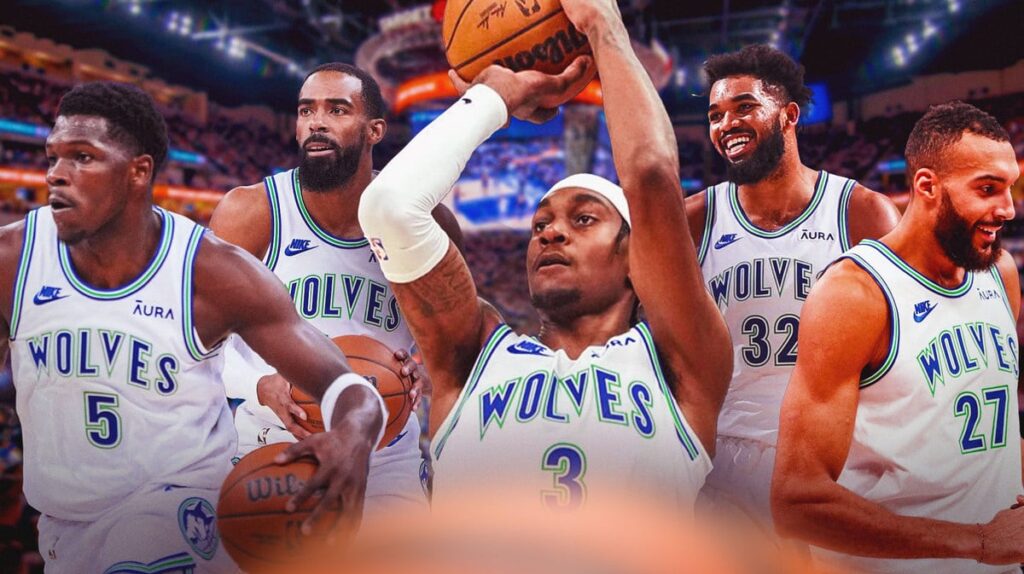Team History
The Minnesota Timberwolves are a professional basketball team based in Minneapolis, Minnesota, competing in the Western Conference of the NBA. The team was founded in 1989, reintroducing the NBA to Minnesota after the departure of the Minneapolis Lakers in 1960. The Timberwolves struggled in their initial years, a common trajectory for expansion teams, as they sought to build a competitive roster and establish a fan base. Despite early challenges, the team’s dedication to growth and improvement laid the foundation for future successes.
In the 1990s, the Timberwolves began to find their footing, notably after drafting Kevin Garnett in 1995. Garnett, who became the face of the franchise, helped lead the team to eight consecutive playoff appearances from 1997 to 2004. This era marked the Timberwolves’ emergence as a competitive force in the NBA, culminating in a Western Conference Finals appearance in 2004. The team’s resilience and growth through these years were emblematic of its fight and determination.
The history of the Minnesota Timberwolves is characterized by periods of rebuilding, notable achievements, and the relentless pursuit of excellence. The franchise has seen the rise of several stars, including Kevin Love and Karl-Anthony Towns, who have contributed to the team’s competitiveness in the modern NBA. Despite facing challenges, the Timberwolves continue to strive for greatness, supported by a passionate fan base and a commitment to community involvement.
Foundation and Early Years
The Minnesota Timberwolves were established in 1989 as part of the NBA’s expansion plan, bringing professional basketball back to Minnesota after a 29-year hiatus. The team’s early years were marked by the typical struggles of an expansion franchise, including difficulty in winning games and building a cohesive team. However, these formative years were crucial for establishing the team’s identity and laying the groundwork for future success.
In their inaugural season, the Timberwolves played their home games at the Metrodome, setting an NBA attendance record, a testament to the excitement and support from the Minnesota fan base. Despite on-court struggles, the early years were characterized by enthusiastic support and the beginning of traditions that continue to this day. The team’s move to the Target Center in 1990 provided a permanent home and helped solidify the Timberwolves’ presence in the NBA landscape.
The drafting of players like Christian Laettner and Isaiah Rider in the early 1990s showed the team’s commitment to building through the draft, a strategy that would eventually lead to the selection of Kevin Garnett. These foundational years, though challenging, were essential in forging the team’s competitive spirit and establishing a foundation that would support future achievements.
Notable Early Achievements
One of the Minnesota Timberwolves’ most notable early achievements was their first playoff appearance in the 1996-1997 season. This marked a significant milestone for the young franchise, signaling its emergence as a competitive team in the league. The Timberwolves’ ability to reach the playoffs after just seven seasons highlighted the team’s growth and the impact of key players like Kevin Garnett, who was quickly becoming one of the NBA’s standout talents.
The 2000s saw the Timberwolves achieving their greatest success to date, reaching the Western Conference Finals in 2004. Led by MVP Kevin Garnett, the team finished the regular season with a franchise-best 58-24 record, securing their first division title. This period represented the pinnacle of the Timberwolves’ early achievements, showcasing a team that could compete with the best in the NBA.
These achievements were not just milestones but also turning points that defined the franchise’s direction. The playoff appearances and deep postseason run in 2004 helped to establish the Timberwolves as a legitimate contender and set the stage for the team’s future endeavors in the league. These successes also helped to foster a strong fan base and build a winning culture within the organization.
Periods of Change
The Minnesota Timberwolves have undergone several periods of change throughout their history, marked by roster overhauls and shifts in team strategy. Following their 2004 Western Conference Finals appearance, the team entered a rebuilding phase, characterized by trades and the departure of key players, including Kevin Garnett in 2007. These changes signaled the end of an era and the beginning of a new chapter focused on rebuilding the team around young talent.
The drafting of Karl-Anthony Towns in 2015 represented a significant moment of change and hope for the franchise. Towns, along with other key acquisitions such as Andrew Wiggins, symbolized the Timberwolves’ commitment to building a competitive team through youth and talent. Despite the challenges inherent in rebuilding, these periods of change have been crucial for the Timberwolves in their pursuit of long-term success and stability.
Management changes, including coaching shifts and front office reorganizations, have also played a critical role in the team’s evolution. These changes have been aimed at creating a winning culture and a sustainable path to success. Through these periods of change, the Timberwolves have remained focused on their goals of competitiveness and championship contention, demonstrating the organization’s resilience and adaptability.
Championships and Achievements
While the Minnesota Timberwolves have yet to secure an NBA championship, the team has achieved several notable accomplishments throughout its history. These include multiple playoff appearances, division titles, and individual accolades for players. The Timberwolves’ 2004 run to the Western Conference Finals remains the team’s deepest playoff run, a testament to the team’s potential and competitiveness.
Players like Kevin Garnett, who earned the NBA MVP award in 2004, and Karl-Anthony Towns, a multiple-time All-Star, have brought individual honors to the team, showcasing the high level of talent that has been part of the Timberwolves’ roster. These achievements highlight the team’s ability to develop and attract elite players, contributing to its competitive standing in the NBA.
The Timberwolves’ commitment to excellence is also reflected in their community engagement and efforts to promote basketball in Minnesota. The team’s achievements on and off the court have made a significant impact, fostering a strong connection with fans and contributing to the growth of basketball in the region.
Current Roster
The current roster of the Minnesota Timberwolves features a mix of promising young talent and experienced veterans, aiming to blend potential with leadership. Led by stars such as Karl-Anthony Towns and D’Angelo Russell, the team is focused on building chemistry and competitiveness. The roster is designed to be versatile and dynamic, with players capable of making an impact on both ends of the floor.
The Timberwolves have also invested in developing young players, viewing them as the foundation for future success. This approach is evident in their draft selections and player development programs. The team’s depth and talent distribution across positions highlight its strategy to compete in the highly competitive Western Conference.
Management’s focus on creating a balanced roster reflects its commitment to achieving long-term success. By combining youth with experience, the Timberwolves aim to establish a competitive team capable of making deep playoff runs and ultimately contending for an NBA championship.
Management and Coaching Staff
The Minnesota Timberwolves’ management and coaching staff play a pivotal role in shaping the team’s direction and culture. The front office, led by the President of Basketball Operations, is responsible for player acquisitions, trades, and overall team strategy. Their decisions are crucial in building a roster that aligns with the team’s long-term vision for success.
The coaching staff, headed by the head coach, focuses on player development, game strategy, and team dynamics. Their leadership is essential in translating the front office’s vision into on-court performance. The staff’s ability to develop young talent and implement effective game plans is key to the Timberwolves’ competitive edge.
The collaboration between the management and coaching staff is vital for fostering a winning culture within the organization. Their joint efforts aim to ensure the Timberwolves are not only competitive but also a team that players and fans can be proud of.
Home Stadium Information
The Minnesota Timberwolves play their home games at the Target Center, located in the heart of Minneapolis. The arena, which opened in 1990, has been the team’s home since its second season and has undergone several renovations to enhance the fan experience and maintain a state-of-the-art facility. With a seating capacity of over 18,000, the Target Center provides an electric atmosphere for basketball games, concerts, and other events.
The arena’s features include modern amenities, advanced technology, and dedicated spaces for fans to enjoy the game day experience. The Target Center’s commitment to sustainability and environmental stewardship is also noteworthy, with initiatives aimed at reducing the venue’s carbon footprint and promoting green practices.
The Target Center is more than just a venue for basketball; it’s a cornerstone of the Minneapolis sports and entertainment landscape. Its central location, coupled with its modern facilities, makes it a beloved destination for Timberwolves fans and visitors alike.
-
*********** ***** ******* *** ***** ** ************ **** ********* *****dd.mm.yyyy 00:00 PM
-
****** *********** **** ** ***** ****** *** **** *** ******: ********* *** ******* *** ****'* ****dd.mm.yyyy 00:00 PM
-
*********-***** ********: **** 6 **** *** ***** *** * ********* **** 7dd.mm.yyyy 00:00 PM
-
**********-************ *******: ****** ****ć, ******* *******, *** * ********* ********** ********dd.mm.yyyy 00:00 PM
-
********* **** ********* ** *** ***: ********* *** ********* ** ****** ******** **. *** *** *****dd.mm.yyyy 00:00 PM
-
****************** ******* **********: *** ********' **** ****dd.mm.yyyy 00:00 PM







